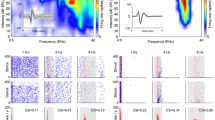Abstract
Scopolamine hydrobromide was injected into the a) septum, b) dorsal hippocampus, or c) lateral ventricles of conscious rabbits via bilateral chronic indwelling cannulas. The cardiac orienting reflex (OR) and heart rate (HR) classical conditioning were assessed. A fourth group of animals received injections of the vehicle solution into these same brain areas and were otherwise similarly trained. Scopolamine had no effect on the cardiac OR produced by unreinforced tone stimuli. The OR consisted of pronounced bradycardia that habituated over successive trials in all groups. The HR change during classical conditioning also consisted of bradycardia. However, these conditional HR changes were attenuated by scopolamine injected into the septum and lateral ventricles, but were not affected by injections into the dorsal hippocampus. These results suggest that centrally applied scopolamine may affect a central nervous system associative process, and not a mechanism directly involved in primary bradycardia.
Similar content being viewed by others
References
Buchanan, S. L., and Powell, D. A. Divergencies in Pavlovian conditioned heart rate and eyeblink responses produced by hippocampectomy in the rabbit.Behavioral and Neural Biology, 1980,30, 20–38.
Deutsch, J. A. The physiological basis of memory.Annual Review of Psychology, 1969,20, 85–104.
Downs, D., Cardozo, C., Schneiderman, N., Yehle, A. L., VanDercar, D. H., and Zwilling, G. Central effects of atropine upon aversive classical conditioning in rabbits.Psychopharmacologia, 1972,23, 319–333.
Fitzgerald, R. D., Martin, G. K., and O’Brien, J. H. Influence of vagal activity on classically conditioned heart rate in rats.Journal of Comparative and Physiological Psychology, 1973,83, 485–491.
Gantt, W. H. Cardiovascular components of the conditioned reflex to pain, food, and other stimuli.Physiological Reviews, 1960,40, 266–291.
Ginn, S. R., Valentine, J. D., and Powell, D. A. Concomitant Pavlovian conditioning of heart rate and leg flexion responses in the rat.Pavlovian Journal of Biological Science, 1983,18, 154–160.
Glowinski, J., and Axelrod, J. Effect of drugs on the uptake, release, and metabolism of3H-norepinephrine in rat brain.Journal of Pharmacology and Experimental Therapeutics, 1966,149, 43.
Harvey, J. A., Gormezano, I., and Cool-Hauser, V. A. Effects of scopolamine and methylscopolamine on classical conditioning of the rabbit nictitating membrane response.Journal of Pharmacology and Experimental Therapeutics, 1983,225, 42–49.
Kazis, E., Milligan, W. L., and Powell, D. A. Autonomic-somatic relationships: Blockade of heart rate and corneoretinal potential responses.Journal of Comparative and Physiological Psychology, 1973,84, 98–100.
Khavari, K. A., and Mickel, R. P. Atropine and atropine methyl bromide effects on behavior of rats.International Journal of Neuropharmacology, 1967,6, 301–306.
Lacey, J. I. The evaluation of autonomic responses: Toward a general solution.Annals of the New York Academy of Sciences, 1956,67, 125–163.
Lacey, B. C., and Lacey, J. I. Cognitive modulation of time-dependent primary bradycardia.Psychophysiology, 1980,17, 209–221.
Lewis, P. R., and Shute, C. C. D. The cholinergic limbic system: Projections to hippocampal formation, medial cortex, nuclei of the ascending cholinergic reticular system and the subfornical organ and supra-optic crest.Brain, 1967,90, 521–540.
Moore, J. W., Goodall, N. A., and Soloman, P. R. Central cholinergic blockade by scopolamine and habituation, classical conditioning, and latent inhibition of the rabbit’s nictitating membrane response.Physiological Psychology, 1976,4, 395–399.
Powell, D. A. Peripheral and central muscarinic cholinergic blockade: Effects on Pavlovian conditioning.Bulletin of the Psychonomic Society, 1979,14, 161–164.
Powell, D. A., and Buchanan, S. L. Autonomicsomatic relationships in the rabbit(Oryctolagus cuniculus): Effects of hippocampal lesions.Physiological Psychology, 1980,8, 455–462.
Powell, D. A., Hernandez, L. L., and Buchanan, S. L. Intraseptal scopolamine impairs Pavlovian eyeblink but not heart rate conditioning.Behavioral Neuroscience, 1985,99, 75–87.
Powell, D. A., and Kazis, E. Blood pressure and heart rate changes accompanying classical eyeblink conditioning in the rabbit (Oryctolagus cuniculus).Psychophysiology, 1976,13, 441–447.
Powell, D. A., Lipkin, M., and Milligan, W. L. Concomitant changes in classically conditioned heart rate and corneoretinal potential discrimination in the rabbit. (Oryctolagus cuniculus).Learning and Motivation, 1974,5, 532–547.
Pribram, K. H., and McGuinness, D. Arousal, activation and effort in the control of attention.Psychological Reviews, 1975,82, 116–149.
Prokasy, W. F. Acquisition of skeletal conditioned responses in Pavlovian conditioning.Psychophysiology, 1984,21, 1–13.
Sawyer, C. J., Everett, J. W., and Green, J. D. The rabbit diencephalon in stereotaxic coordinates.Journal of Comparative Neurology, 1954,101, 801–824.
Solomon, P., and Gottfried, K. E. The septohippocampal cholinergic system and classical conditioning of the rabbit’s nictitating membrane response.Journal of Comparative and Physiological Psychology, 1981,95, 322–330.
Solomon, P. R., Solomon, S. D., VanderSchaff, E., and Perry, H. E. Altered activity in the hippocampus is more detrimental to classical conditioning than removing the structure.Science, 1983,220, 329–331.
Szerb, J. C. Characterization of presynaptic muscarinic receptors in central cholinergic neurons. In D. J. Jenden (Ed.),Cholinergic Mechanisms and Psychopharmacology. New York: Plenum Press, 1978.
Yamamura, H. I., and Snyder, S. H. Postsynaptic localization of muscarinic cholinergic receptor binding in rat hippocampus.Brain Research, 1974,78, 320–326.
Author information
Authors and Affiliations
Additional information
This research was supported by VA Institutional Research Funds awarded to the Wm. Jennings Bryan Dorn Veterans’ Hospital, Columbia, South Carolina.
Rights and permissions
About this article
Cite this article
Powell, D.A., Buchanan, S. & Hernández, L. Intracerebral scopolamine administration attenuates Pavlovian heart rate conditioning in the rabbit. Pav. J. Biol. Sci. 20, 116–123 (1985). https://doi.org/10.1007/BF03003594
Issue Date:
DOI: https://doi.org/10.1007/BF03003594



